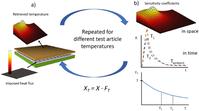Non-linear Non-Iterative transient inverse conjugate heat transfer method applied to microelectronics
Non-linear Non-Iterative transient inverse conjugate heat transfer method applied to microelectronics
| Event Date: | May 1, 2020 |
|---|---|
| Authors: | D. Gonzalez Cuadrado, A. Marconnet, and G. Paniagua |
| Journal: | International Journal of Heat and Mass Transfer |
| Paper URL: | Link to Full Text |
Solving for temperature profiles given boundary conditions, geometry, and material properties is relatively straightforward given the wealth of analytical and computational techniques available. However, experimentally we often measure temperatures and seek to understand unknown boundary conditions or material properties. This problem is generally ill-posed. Thus, to get the value of these input parameters, we use inverse methods: knowing the output of the system (i.e., temperature), we can compute the value of the unknown parameters (e.g., thermal conductivity or heat fluxes). In microelectronics, the location and magnitude of the boundary conditions including local heat generation rates are often unknown or difficult to model due to the compactness of the current microchips and active thermal management schemes that distribute computations between different cores causing time-varying heat generation within the chips. This information can be retrieved using inverse heat transfer methodologies by tracking the temperature distributions in space and time. In this work, we develop a new, non-iterative inverse methodology to retrieve the heat flux inside of 3D geometries of stacked microchips. This method not only provides good agreement between the imposed and the retrieved heat flux with a linear form of the heat diffusion equation, but also predicts the imposed heat flux with good accuracy in situations with non-linearities. Here we numerically and experimentally validate our new approach using a microchip with 25 heaters that can be operated independently to create different spatial and temporal heat flux patterns. During testing, the system is in a controlled environmental chamber and the temporal and spatially varying temperature of the top surface of the chip is measured using infrared thermography for input to the inverse method. The system and model include non-linearities through varying convective heat transfer boundary conditions on different parts of a test article and temperature-dependent thermal properties of the constituent materials. The inverse methodology retrieves the local heat generation rates with good agreement in time, space, and magnitude. An uncertainty analysis of the computation and the experiments is also detailed. Our methodology is unique compared to past work because non-linearity is solved without the need of using iterative processes, which makes the algorithm computationally efficient. Ultimately, this method is useful for the determination of the location and magnitude of the heat flux in any 3D system based on external temperature measurements with real heat transfer properties without the need of an iterative procedure.

